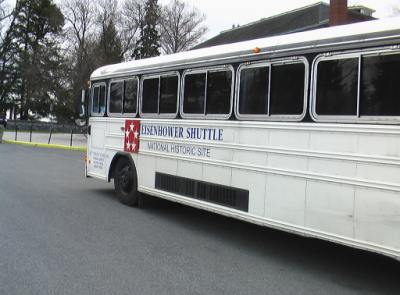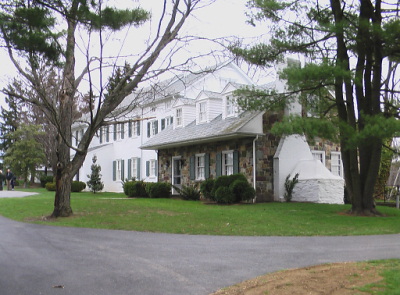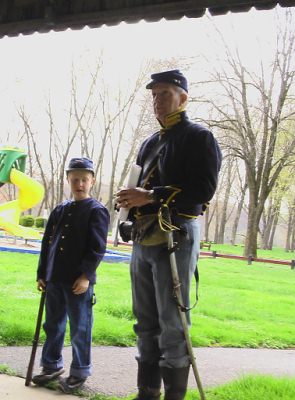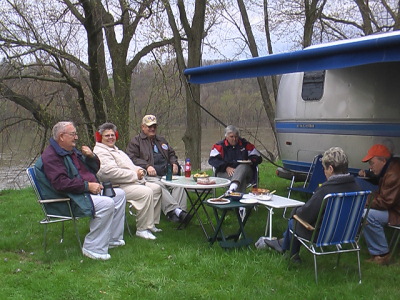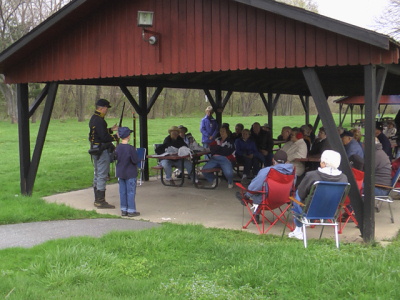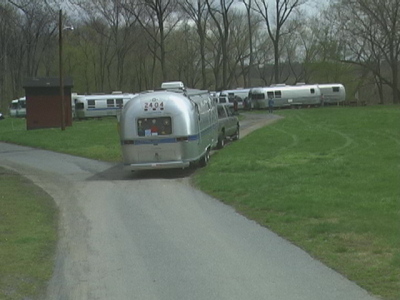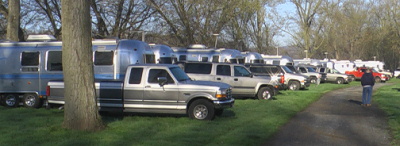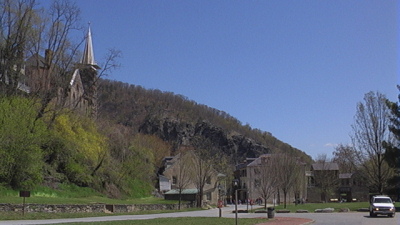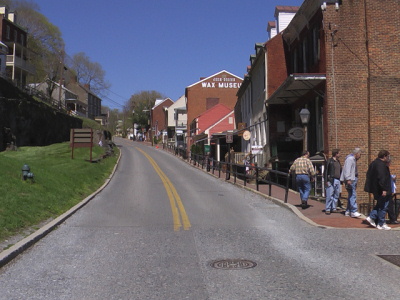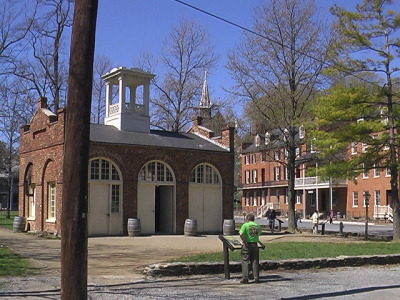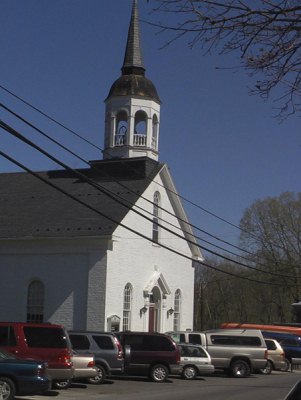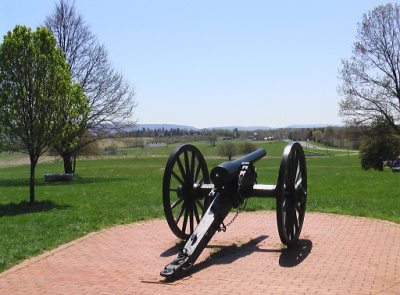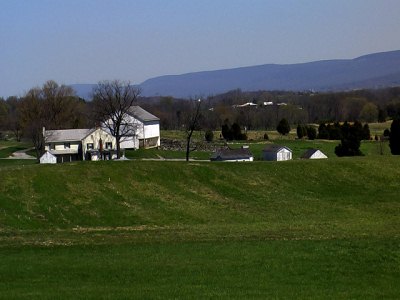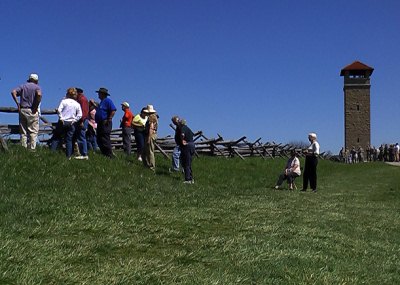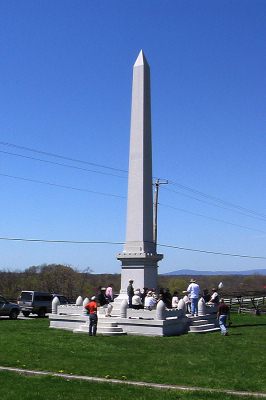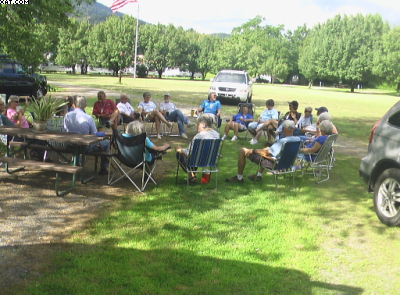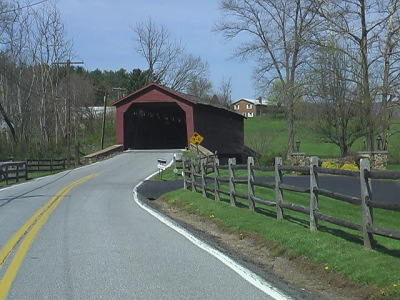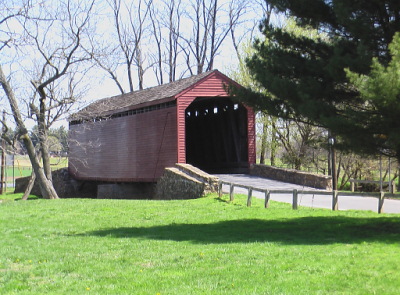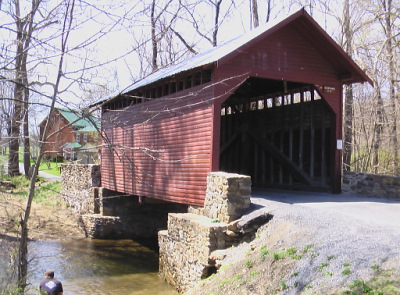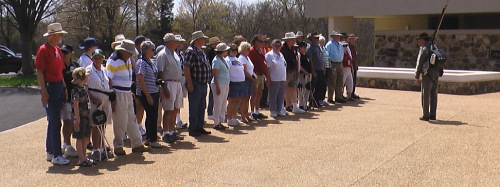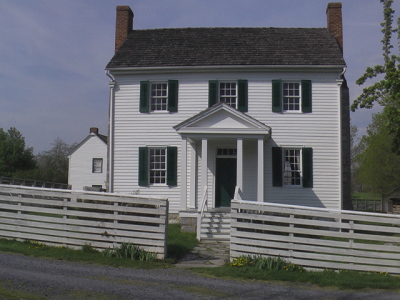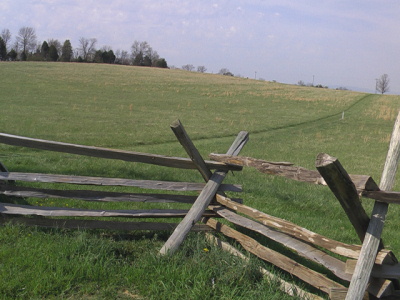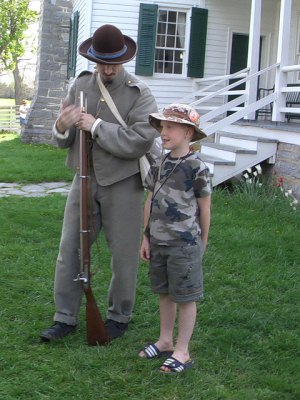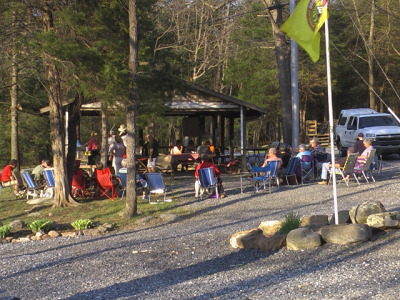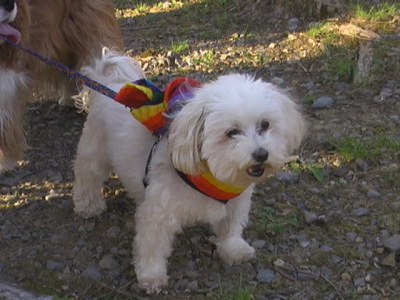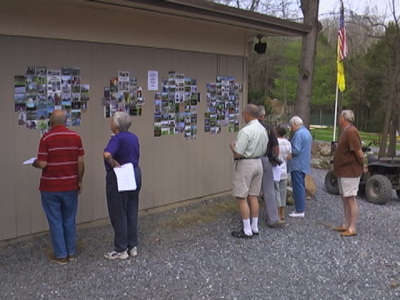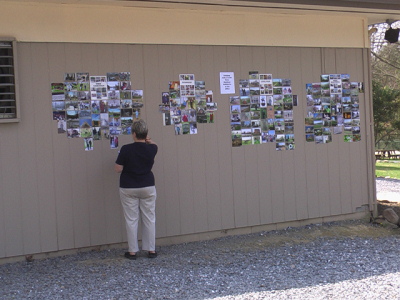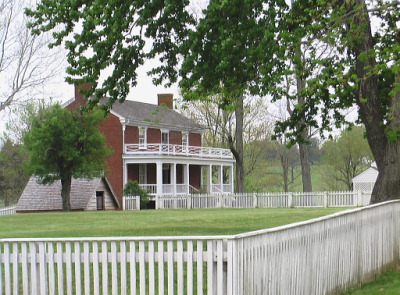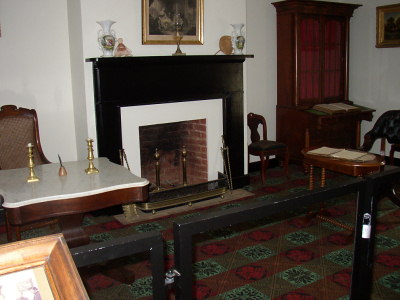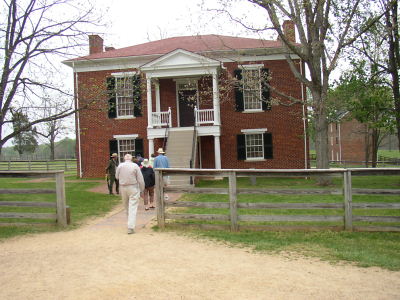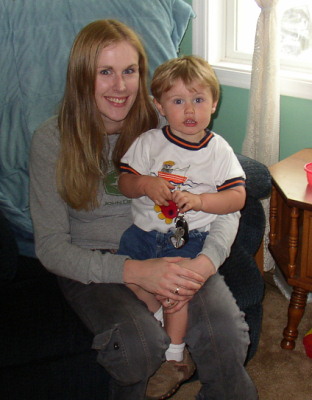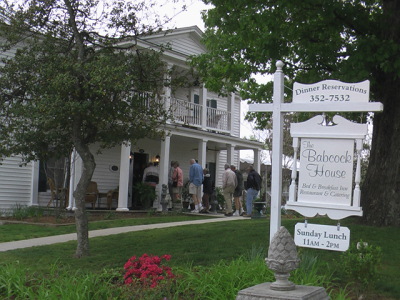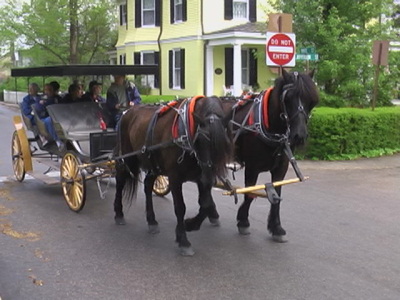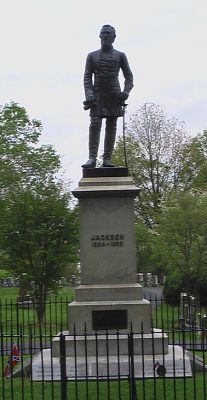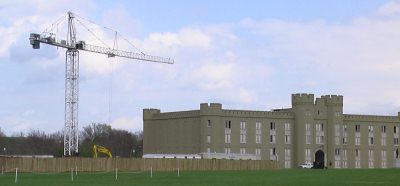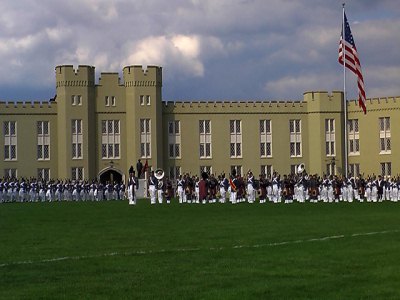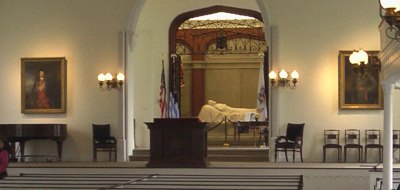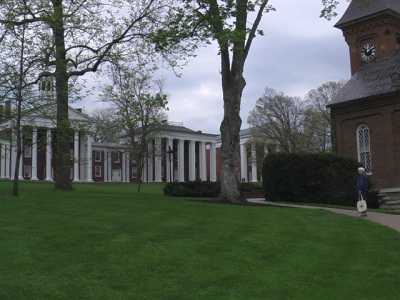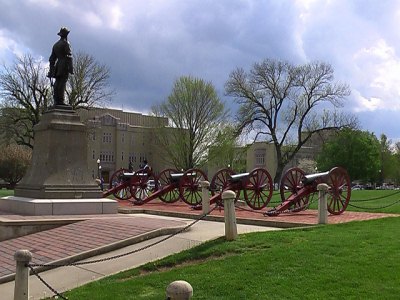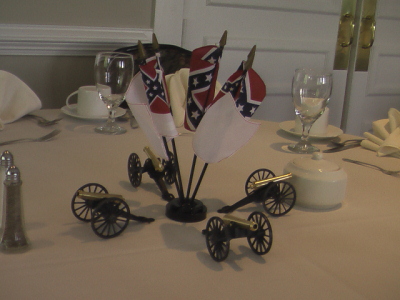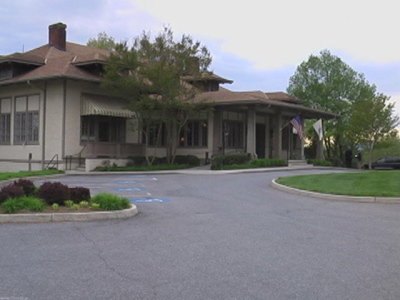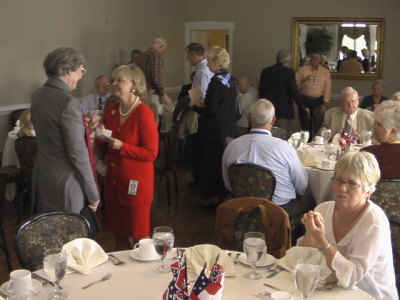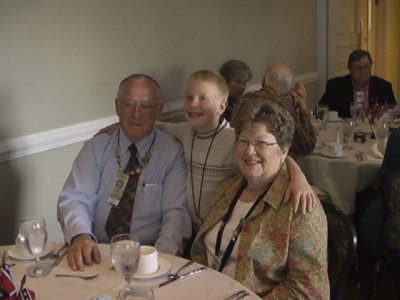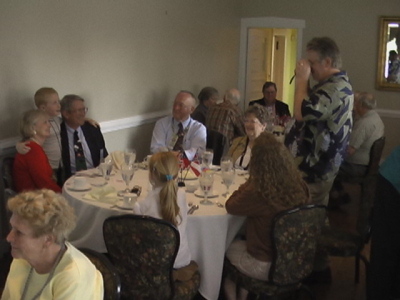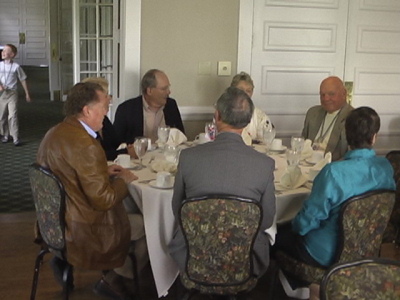Tuesday, April 17, 2007 - Today was a departure from the Civil War theme. We visited the Eisenhower farm near Gettysburg. We loaded onto a shuttle bus at the Visitor Center and drove about five miles to the farm. Because of a backlog of tours, we were herded into a cattle barn - not a good first impression. The ranger was obviously killing time to allow the earlier tours time to vacate the house. The move did get us out of the wind and cold while we waited.
The Eisenhowers bought the 189 acre farm in 1950, thinking it a good place to retire after 30 years in the army and a few years as president of Columbia University. Retirement had to wait, however, because he was summoned by President Truman to assist in the forming of NATO as Supreme Commander. Then came the call to run for the presidency which occupied his time for the next eight years. Finally, in 1960 he was able to enjoy his farm, the only home he ever owned, until his death in 1969. He and Mamie gifted the farm to the National Park Service to take effect upon her death which occurred in 1979. It is now preserved just the way the Eisenhowers left it, including their furniture, books, and collections. The farm has been visited by many heads of state, both during Ike's presidency and afterward, including Charles DeGaulle of France and Nikita Krushchev of the Soviet Union. Ike was a popular president, maybe the most popular of the 20th century.
The tour of the house was quite interesting and erased the first impression of the cow barn. Following the Eisenhower farm tour, we gathered at a local pizza parlor for a caravan kitty fee lunch. The rest of the day was free time.
Wednesday, April 18, 2007 - This was a free day - no caravan activities - so we did a little sightseeing around the county, did the laundry, replenished groceries, but mostly just relaxed around the motorhome. The sun was shining brightly at the day's beginning, but by afternoon, dark clouds were back. We drove into the town of Gettysburg, then took a back road up into the mountains. There were many apple and peach orchards that will be beautiful when new bloom arrives.
Thursday, April 19, 2007 - We moved today to Brunswick, Maryland to a rather unique campground on the banks of the Potomac River. For the first time we were parked in a tight group with no other RVs in sight. Once everyone was in place and settled in, Ed Jones and Nathan donned their Civil War uniforms and gave us a presentation on his gear used as a Union Cavalry reenactor. Nathan stood at attention by Ed's side for the full hour.
Later, we gathered for our fifth and last GAM, this time at the trailer of Frank and Colleen Hilzinger. Present were Winston and Carol Montague, Walter and Ann Berg, Floyd and Donna Tschacher, beside the Hilzingers. Introductions were made, though
redundant at this point. Floyd kept us in stitches with his stories of his father flying airplanes in Montana.
Then it was time for a cookout - this time it was "chicken spectacular" prepared in our leader's dutch ovens, enjoyed by everyone. The sun made its appearance for short times late in the day with promises to shine brightly for the next two days.
Friday, April 20, 2007 - We gathered to travel at 9:15am the short ten mile journey to Harpers Ferry. The sky was clear with a bright sun for the first time in many days. We caught the shuttle bus from the Visitors Center into the old town area - a National Historical Park since 1944.
Located at the confluence of the Shenandoah and Potomac Rivers on the northeast tip of West Virginia, Harpers Ferry is in a beautiful setting. Rugged mountains surround the town. The rangers claim that the "Industrial Revolution" began here. At the end of the 18th century the new nation needed an arms manufacturing facility. Harpers Ferry was chosen. In the next fifty years it became a highly industrialized community with the first application of the idea of interchangeable parts for rifles. A federal stockpile of guns and ammunition was stored here. It was that stockpile that attracted John Brown and his raiders in 1859.
John Brown thought that he could steal all those rifles and arm the slaves so they could free themselves. His raid took the town by surprise, and he actually held control for 36 hours. Then the marines came under the command of Col. Robert E. Lee and stormed the old fire house where he had holed up. Several of his men were killed, and Brown was captured. He was tried for treason and hanged in nearby Charles Town. When news of his execution reached his abolitionist friends in the north, John Brown became a martyr to the cause of freeing the slaves. He also became the catalyst that led to secession and the Civil War two years later. We heard that Stonewall Jackson brought a corps of VMI cadets in to witness the hanging and guard against disruption.
Because of the armory, Harpers Ferry was a prize sought by both Union and Confederacy during the war. Control of the town was exchanged eight times. Stonewall Jackson returned during the war and captured 12,000 Union troops along with a major cache of supplies.
The war so devastated the citizenry, that the civilian population dwindled from 3,000 to a couple hundred. Subsequent flooding wiped out any rebuilding effort after the war, and Harpers Ferry became a ghost town until the Park Service came in during modern times.
The Appalachian Trail goes directly through the old town of Harpers Ferry and crosses a footbridge that parallels the railroad tracks to Maryland on the other side of the Potomac. Some of us walked the old trail from the Loudoun Heights cemetery, down the steps cut into the steep rock cliff, through the lower town, and across the railroad tressle into Maryland on the banks of the Shenandoah River where it joins the Potomac. We walked through the streets of the old town, visited some museums, listened to a park ranger program, and ate lunch before driving back to camp.
Saturday, April 21, 2007 - The day began at the Salem United Methodist Church in Keedysville, Maryland as we gathered there for a serendipitous breakfast. Our leaders just happened to see a sign advertising a pancake and sausage breakfast at the church and made arrangements for us to eat there. We later learned that this was something the church does twice a year to raise funds - and it was an especially good "all you can eat" meal. This old church was established two years before the Declaration of Independence - before 1774.
From there we drove to the Antietam National Battlefield for a one hour movie and a three hour guided tour. If just a tenth of what we heard could be remembered, we'd all be experts on this Civil War engagement. The Antietam battle took place on September 17, 1862 after several days of buildup. Fighting was ferocious with a total of 38,368 casualties - almost 26,000 on the Confederate side. Both sides claimed victory, though the results were tactically inconclusive. Both sides claimed victory. In numbers of casualties, the Confederacy lost more. If it was the South's intent to move on to Washington, they were stopped. If it was the North's intent to destroy the Confederate army, they clearly failed in that. But Lincoln claimed victory and found in that claim encouragement to publish his Proclamation Emancipation. Our guide argued that it was Antietam rather than Gettysburg that was the turning point for the Confederacy. Whatever the result it demonstrated the insanity of the war.
The countryside around the battlefield is beautiful - rolling hills with the Blue Ridge mountains in the background. The park service has done an excellent job in restoring and preserving the battlefield, and the guides did a super job.
Soon it was time for a catered dinner at the Community Center in Reedyville - fried chicken, pot roast, lima beans, string beans, potatoes, and the fixin's. By the end of all that we were soundly exhausted, yet it had been a good day - lots of sunshine, warmth, good food, walking exercise, and education.
Sunday, April 22, 2007 - Unable to spot a Baptist church to attend, we went in search of the three covered bridges of Frederick County - all near the town of Thurmont. After driving through some nice countryside on back roads, we spotted on a side road the first bridge, called the Utica Mills Covered Bridge. A little further along Old Frederick Road, the road itself passed through the Loy's Station Covered Bridge. A park near the bridge afforded several scenic views, and a story board stated that Lee's retreat from Gettysburg took this route and presumably crossed this bridge.
Finding the third bridge was a challenge as the roads were not well marked, but we were persistent and found it - the Roddy Road Covered Bridge. All three bridges are in good repair and still in use.
Later in the evening our leader Larry brought out his dutch ovens again to prepare peach cobbler which was served with ice cream, funded by the Sheriff Nathan's fines. Then Larry led a drivers meeting, going over the 100 mile route to New Market and tomorrow's schedule.
Monday, April 23, 2007 - It was with some reluctance that we left our beautiful campsite on the banks of the Potomac River in Brunswick, Maryland. It had been a nice four night stay with excellent weather.
The 100 mile trip south from Brunswick took us by Harpers Ferry again, through a corner of West Virginia, and on to a KOA campground a few miles south of New Market, Virginia.
There was just enough time after settling in to get ready for a car caravan to the VMI Hall of Valor Civil War Museum. We were greeted by an animated guide in his Confederate uniform. The museum immortalizes the 257 young cadets from the Virginia Military Institute who, back on the 15th of May, 1864, turned the tide of battle, giving victory to the Confederates. Ten of the students lost their lives in the Battle of New Market which turned out to be the last Confederate victory in the Shenandoah Valley campaign.
Our guide lined us up in two lines, military style, to march us into the museum where we viewed the exhibits and watched an hour long movie entitled The Field of Lost Shoes.
We then walked over to the Bushong House, learning that this family was at home during the 1864 battle that took place on their land. We then walked through the apple orchard to the fence at the bottom of the hill that marked the beginning of the cadet charge.
Touring the battlefield brought back memories of a day back in 2000 when we watched our grandson John participate as a VMI “Rat” in the annual re-enactment of the Battle of New Market. He graduated in 2004. In those exercises, the Rats line up at the fence in full uniform and on command make the charge up the hill through the Field of Lost Shoes into the face of the Union cannons.
Back at camp Susan Stone conducted a pet show. There was one cat – Amanda – who was thoroughly intimidated by the host of dogs – Joey, Governor, Isabella, Pepper, Dave, Winston, Minnie, Rusty, and Streamer are a few of the names that we could remember. Prizes were given in several categories. The competition was friendly and much enjoyed by all.
Larry and Carol broke out their dutch ovens again to cook up a big batch of chicken pot pie. Served with a cup of fruit, this was a hearty meal enjoyed under the picnic shelter at the campground.
Tuesday, April 24, 2007 - This was a free day so the caravanners scattered, some playing golf, some doing laundry, some just relaxing in the park or working on their rigs. John Hice posted all the pictures that folks had given him to enter into a photo contest. Then, everyone studied the posting and voted on the Best of Show, Best Caravan Picture, Funniest, Best Civil War shot, and the Most Beautiful. There were over 50 entries. Contest winners will be announced at our final banquet.
Wednesday, April 25, 2007 - This was moving day, and our assignment was to go with the early crew as parkers, and then to assist in getting everyone parked in the new campsite - Thousand Trails Campground near Rustburg, Virginia. We had 150 miles to go from New Market to Rustburg, and all went well with a couple of impromptu detours, Our assignment lasted until 4:00pm, although there were three units still not in by then. One motorhome had trouble, and repairs made them late. The other two had announced earlier that they were visiting friends along the way.
For supper we gathered in a recreation building and enjoyed sandwiches from Subway along with icecream and cake to celebrate some 50 years anniversaries.
Thursday, April 26, 2007 - We visited Appomattox Courthouse on this day, carpooling into the National Historic Site where General Lee surrendered to General Grant to effectively end the American Civil War and reunite the nation. That historic event occurred on April 9, 1864, almost four years after the firing on Fort Sumter that started the war. What a costly four years! Over 600,000 young men dead. Huge losses in property damage. The nation would recover, but it took a century.
The surrender meeting took place in the parlor of the William McLean home, a short block from the actual courthouse which is now the park's Visitor Center and museum. All of the buildings which existed in the vicinity in 1864 have been restored to their condition at the time. The Confederates had to surrender their weapons, but were then released to make their way home - most walking, some barefoot - foraging to find food. Some had to walk 1,000 miles. Those that had them were allowed to keep their horses.
While Appomattox represents the end of the Confederacy, it, in fact, was only the surrender of the Army of Northern Virginia, and isolated fighting continued in other areas until June of 1864. Ironically, the last battle took place in Palmyra, Texas, and it was won by the Confederates.
At noon, we drove into town to the Babcock House for a "cold buffet." This was an historic old home that is now a Bed and Breakfast Inn, and the meal was delicious,
Following the lunch, we drove to Drakes Branch, Virginia to visit our granddaughter and great grandson. Her husband was working, so we missed him, but had a good reunion with mother and son.
Friday, April 27, 2007 - After the surrender, General Lee returned to his home in Richmond, but he was virtually a prisoner in his own home because of admiring crowds. Pressure increased as did his popularity. One of the many offers he received was the presidency of Washington College. Deciding to accept that position, he moved his family to Lexington, Virginia and for the next five years devoted his time to the school. Health problems continued to plague him, however, and he died in 1869. Today his tomb is enshrined at the Lee Chapel in Lexington. His wife and seven children are there with him. His horse Traveller is buried right outside the building.
Despite a rainy night and a gloomy start to the day, we had an especially good time in Lexington. As the day progressed the weather improved until the sun came out to stay about parade time at VMI. We began at the Lexington Visitor Center where horsedrawn carriages were awaiting us for a tour of the historic city, We passed Lee Chapel where the Lees are buried. Then came the Washington & Lee Campus, several beautiful old homes, and the Stonewall Jackson Cemetery. At the end of the tour we walked a block to the Jackson home where many of Stonewall's possessions have been recovered and are there.
We were then free to wander around town and eat lunch before again gathering for a guided tour of the Jackson Cemetery. A costumed guide pointed out the grave of Stonewall Jackson, many of his officers, and others who were important to the history of Washington and Lee University and VMI - the Virginia Military Institute. Jackson was brought back to Lexington for burial because it was his prewar home and because of his prewar association with VMI.
We then drove to the parade ground of VMI where a portion of the field has been roped off for parking. After a visit to the George Marshall museum - VMI's most illustrious graduate (class of 1901), we were led around the campus by a cadet guide who first pointed out the memorial to the ten cadets who lost their lives in the Battle of New Market during the Civil War. He then described some of the classroom buildings, showed us the Admissions Building, the alumni hall, the Superintendent's home, the barracks, the VMI museum, and several other buildings. He also described some of the new construction. A new barracks building will house an additional 500 cadets when complete in 2011.
Then it was time for the weekly Friday afternoon parade - a march in review before the Superintendent. Led by the marching band, all 1300 cadets marched out, divided into their eight companies, After a rifle drill which included the fastening of bayonets, the parade continued as the companies marched by the reviewing stand and back to their barracks - all very impressive. We were fortunate to have folding chairs in which to sit while watching.
We arrived back home shortly before dark. The day in Lexington - our last activity other than the final banquet - had been one of the highlights of the caravan.
Saturday, April 28, 2007 - This was a day to relax and reflect on what we had seen and heard on the battlefields and in the museums that have so thoroughly preserved the most tragic event in America's history - the American Civil War, Men on both sides endured indescribable hardship and fought valiantly for what they believed in, then put their differences aside and reunited as a nation. Someone said that to ignore history was to invite its repetition. No one could ever want to repeat the horrors of this war, so we have to learn from it - and that's what this caravan has been all about.
Our leaders did an incredible job of planning our activities so as to maximize the learning experience.
As we visited Fort Monroe, Richmond, Petersburg, Fredericksburg, Chancellorsville, Manassas, Gettysburg, Antietam, New Market, and Appomattox, and as we listened to the enlightened guides at each place, that war of 145 years ago became real, as did the men who fought in it - Lee, Jackson, Grant, Longstreet, Pickett, Stuart, Meade, McClellan, Johnston, and the thousands of soldiers many of whom lie in unmarked graves. The stories of bloodshed and the visits to graveyards brought it all home with an intensity some of us didn't like too much - but we still learned, and we are the better for it.
The final banquet of the caravan was held at the Oakwood Country Club in Lynchburg, Virginia. Results of the photo contest, hat quiz, distribution of the caravan journals, gifts to the sheriff, a poetic tribute to the leaders, and a great meal made for a fitting end to the caravan. It's always hard to say goodbye to a new set of friends, but all good things have to end. We'd had a great time together. The next morning we parted, everyone going their own way. and that was it.
If you've logged on to this web site and read this travelog, I'd appreciate an email to let me know and to make any comments you might have. Thanks. My email address is: whberg@hughes.net

